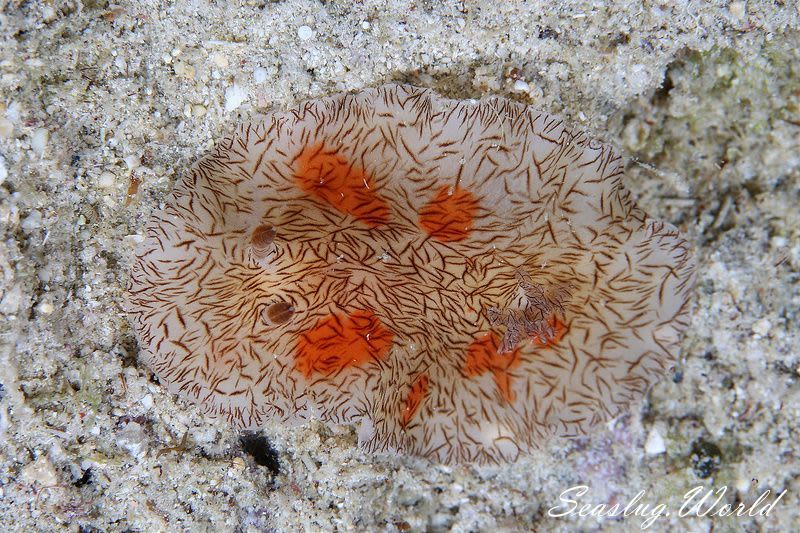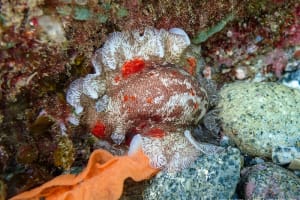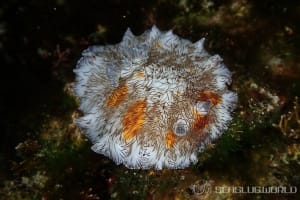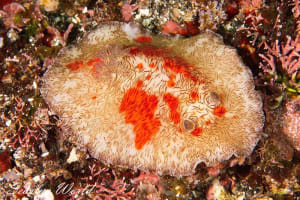Platydoris cruenta (Quoy & Gaimard, 1832)

- Photographed by
-
今川郁
- Location
- Cape Maeda, Hontou (West coast), Okinawa, Japan
- Date
- 2015/05/15
- Length
- 50mm
- Depth
- 3.0m
- Water temperature
- 24.0℃
MORPHOLOGY
The body shape is flat and wide (Fig. 6B). The dorsum is covered with small caryophyllidia. The rhinophoral and branchial sheaths are elevated. The branchial sheath has six branchial lobes, with the anterior and posterior ones being larger than the others. The gill is com- posed of six tripinnate branchial leaves. The perfoliate rhino- phores always have 37 lamellae. The background colour of the living animals is white or cream. There are numerous short, thin, wavy brown lines on the dorsum. These lines nor- mally cover the entire dorsum, but they may be absent fromportions of the dorsum in some specimens. In some speci- mens there may be large red spots on the dorsum, in some cases covering large portions of the body. Both lines and red blotches varying in size and distribution are also present on the ventral side of some specimens, especially surrounding the foot (Fig. 2F). Rhinophores and branchial leaves are the same colour or darker than the dorsum and are also covered with brown lines. There are irregular dark lines on the rachises of the gill lamellae.
DISTRIBUTION
This species is widely distributed throughout the tropical Indo-Pacific. It was recorded from South Africa (Gosliner 1987), Sri Lanka (Kelaart 1858), Indonesia (Quoy & Gaimard 1832–1833), Australia — from Western Australia to New South Wales (Wells & Bryce 1993), Papua New Guinea (present paper), Fiji (Brodie & Brodie 1995; present paper), the Marshall Islands (Johnson & Boucher 1983), Japan (Eliot 1913), New Caledonia (Risbec 1928), Vietnam (Risbec 1956) and the Philippines (Bergh 1877a).References
- ユウゼンウミウシ(新稱), Baba, K. & Hamatani, I. 1952a. 紀州産後鰓類目録. List of the species of the opisthobranchia from Kii, Middle-Japan. NankiSeibutsu [南紀生物] Supplement 1: 1–11.
- ユウゼンウミウシ, 奥谷 喬司. (2000). 日本近海産貝類図鑑.
- Dorgan K.M., Valdés Á. & Gosliner T.M. (2002). Phylogenetic systematics of the genus Platydoris (Mollusca, Nudibranchia, Doridoidea) with descriptions of six new species. Zoologica Scripta 31 (3): 271–319
- ユウゼンウミウシ, 小野 篤司. (2004). 沖縄のウミウシ.
- ユウゼンウミウシ, 中野 理枝. (2004). 本州のウミウシ.
- ユウゼンウミウシ, 中野 理枝. (2018). 日本のウミウシ.
- Platydoris cruenta, Terrence Gosliner, Ángel Valdés and David Behrens. (2018). Nudibranch and Sea Slug Identification Indo-Pacific 2nd Edition. New World Pubns Inc.













